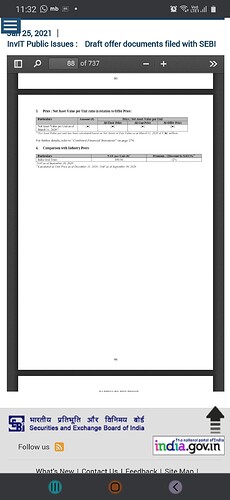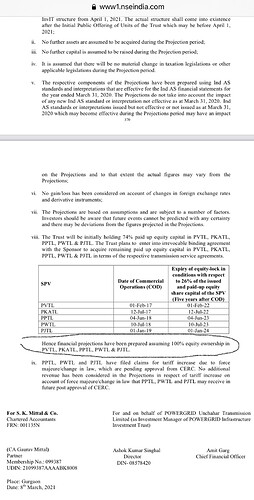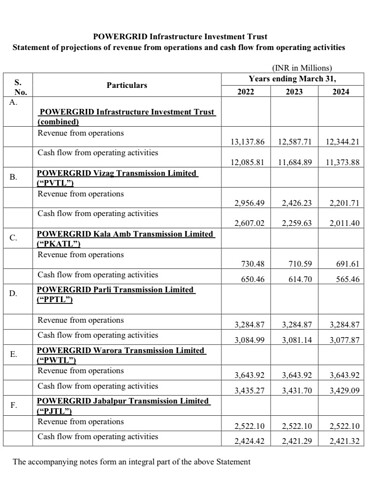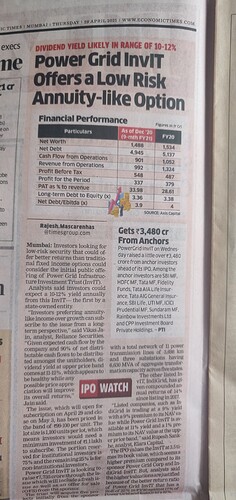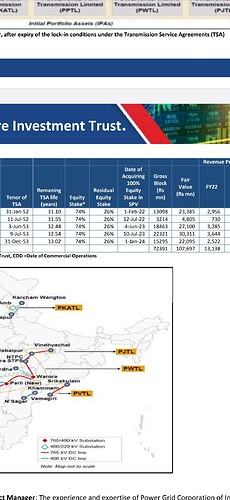Hey @Investor_No_1 It’s just an alternative to physical Real estate. I have always been planning to own my 2 offices for my business but I’ve realised going the REIT route makes more financial sense and what I know for a fact is apart from 1 residential property to live in il be ignoring RE for investment purposes since they just don’t make sense regards returns. It’s almost like a light bulb coming on regards RE vs REIT as an investment. There’s no change to the ITC plan. It will always remain the main company I invest in for my portfolio but the capital I’d pre allocated for commercial offices/a second home will just go to REITs instead over the next few years(though over a basket of them and not just embassy). It feels like a burden has been lifted off my shoulders considering i was struggling to figure out how to handle growing my networth with a portfolio AND via real estate without going neckdeep into debt and REITs have solved that issue. And yes… my understanding regards them has improved. They feel like a no maintenance easy asset to understand and one that is easy to figure out fair value of too ( discount to NAV is time to buy) and also acts as an emergency fund to dip into when it rises far above NAV. I am not a fan of FDs or debt funds so this seems the perfect compromise to de risk my portfolio too(even though it isn’t a debt instrument it fits my risk profile as one perfectly)
Thanks, no one could have explained that better than what you have done in your post above. On lighter note, you can be a great writer as well as very few have the gift of getting across the exact thoughts and feelings through words and you seem to have it all ![]()
![]()
Good to know there is no change to ITC plan. I would share my views here (although its your thread and my views do not matter much but for healthy discussion and learning purpose sharing)…as per me if I were to chose between ITC vs REIT for purpose of capital protection and/or dividend and/or regular income…I would always chose an ITC for my limited capital. I would chose an ITC over FD as well unless I have to be immediately dependent on the regular income in which case still I would allocate decent percentage to ITC. (Here ITC stands for not just ITC but any equity company which is of status ITC - ethical management, growing segment, fairly valued at present, excellent div yield and ability of the yield growing with time).
The sole reason for above with equity winning hands down over REIT for me is - In Equity, I invest where I trust the ethics of the management (sponsor). In REIT - if ever there will be a sponsor of the likes of TATAs etc. my views would dramatically change. Even though today, PEs are involved in REITs (PEs are known for exits and medium term views at best) still the sponsor and influence of the builders cannot be ruled out. Can you trust a financial instrument being owned by these builders? In Physical RE, they hand over the asset to us and its completely owned by us and how we develop it or use it.
Now coming to alternative of Physical RE and if we do not invest in physical RE and have an allocated amount for Physical RE, where would I put that amount in due course…This is a very tough decision to make considering the above scenario of REITs at present wherein I am unable to develop trust in the sponsor community.
Maybe I would chose to do a mix of solid FMCG firms, tax free bonds, NPS, PPF, FDs and some REITs but not solely REITs
Once again, if sponsors would have been the likes of TATAs (or even Godrej Properties etc.) - views would change dramatically in favor of REITs.
In short, if the same category of sponsors can cause havoc in actual Physical RE and RE stocks, what stops them from using loop holes in REITs/INVITs etc to their massive advantage only to probably end in some kind of big blow up of eventual fraud in a decade or so (We know the NBFC crisis only when it happened and any financial instrument with weak sponsors - I would be wary). Even ILF&S had marquee names associated with it, so have the REITs today with PEs…but what about the sponsors sitting at top?
Disc: Pls note above are just my assessment and I maybe totally wrong. Not a buy/sell recommendation at all. Only for educational purpose.
Cheers @Investor_No_1 … and thanks for the compliment. I’ve set myself a target for the next decade and I’m very stubborn in my thinking lol. Maybe my overall plan for until then will put everything into perspective since I’ve just been posting in bits and pieces so far. Covid has basically slowed down my main business and has probably set it back a few years so hence why I have to have as high conviction in my plan as possible for the next decade.
Part 1:
I currently have 72 percent of my networth in Laurus Labs(47 percent) and Deepak Nitrite(25 percent). As things stand I am thoroughly convinced they’ll be 100,000 MCAP companies in the next 5 to 10 years and my main purpose over the next decade is to protect what i’ve invested here and ensure that based on quarter results/annual reports/concalls that this target comes to fruition. I will only book some profits here and rebalance my portfolio if and when they reach this crazy target or exit if huge corporate governance issues prop up. So my main job is now to protect my investments in these two companies.
Part 2:
20+ percent of my networth is invested in Vaibhav Global + Intellect Design Arena + Jubilant Ingrevia + Just Dial + Borosil etc. These are a mix of small and microcaps. Again, I don’t want to add too much here and my aim is to protect these risky investments since I forsee huge growth here. However, my portfolio is risky as it is with so much invested in just 2 companies above so I cannot afford to expose myself much further here and hence why I need the relative safety of Large caps and REITs now since the opportunity cost of the markets being at lows from last year is now gone so I can aim for stability in low risk investments
Part 3:
Aprrox 8 percent of my portfolio is currently invested in ITC + Idfc First. Like I said earlier my aim is to protect Part 1 and Part 2. So hence why I now need stability. ITC I’ve mentioned a countless times above regards why it’s my favorite company. Majority of my savings over the next 5 years will go into it. Idfc first is a low risk large cap that will remain undervalued for a while too and will be the second place I invest in on dips. The plan is to increase allocation in these two in such a manner that they take up atleast 30 percent of my portfolio via deployment of my savings next few years.
Part 4:
Covid made me realise the importance of a yield asset since when the world stops… expenses don’t. Over the next decade REITs and similar yield instruments will be my next target. Once I’m happy with my Share of ITC and IDFC first (they won’t stay in a buying range forever) il be buying these. Infact whenever Part 1 reaches its desired target the profits booked will be invested here with the aim being to raise a yearly yield from these + ITC + the rest of my portfolio to match my expenses so that I can run my business in total peace and grow my networth too in the background.
Basically, I’ve used the opportunities in the market over the past year to invest in once in a lifetime opportunities… will use the next few years to invest in stable undervalued large caps to cover the huge risks I’ve taken… And will build dividend yield assets to complete the portfolio and cover expenses.
It will take me atleast 8 to 10 years to systematically do the above and it seems a bit stupid to have such a long term plan but it’s the best way for me to ignore all the noise and set my sights over a long period like a decade and gives me clarity of thought and makes saving a certain amount every month a priority for me. In 10 years il have a standard portfolio distributed evenly among small caps + Large caps + dividend yield debt substitutes. Instead of settling for it from the start I have just spread the process out over a decade instead of starting with it so I could make full use of the covid crash and bull run over the past year 
Malkd any view on power grid invit?
@Rahul_Singh
I will be investing in it for my wife’s portfolio.
Reits and Invits are a huge part of my strategy with my wife’s capital protection + income portfolio so il be betting on any Invits/REITs that come backed with good promoters so I will be investing here too.
The only iPos I ever take a part in will be REITs/Invits too since by their nature if you want them long term the IPO price is a good starting point to begin investment and there is a good chance of allotment too due to bigger ticket size.
Will be applying for the maximum 1 lot for the IPO and will buy further lots as the quarters go by and a clearer idea of the yield comes through.
The promoters, the long life and stability of the assets and huge runway for growth make this a good play for the long term for the risk profile I’ve kept for her portfolio.
The risks are that we don’t know how well they’ll handle the balancing act of debt+distribution in the future and what the yield will be like currently with just 5 assets(1150 crores over 3 years looks the target but I’d like to see actual distributions for a few quarters). Since I bet big in just a few capital appreciation + yield asset in her portfolio (all of her money is basically in ITC, Rites, Oracle , Embassy, Indigrid) il need to see a bit more before investing more than the IPO amount…
That being said i have set aside the capital to bet big over FY22 as the quarter results and commentary comes in.
I need my thesis to be pitch perfect here due to the high entry barriers I have when it comes to risk in her portfolio(and balancing them with concentration risks of just a few companies) and it being my wife’s business income lol. Even with all the studying I’ve done so far I don’t feel I’m any where close to how prepared I was with the other 5 companies in her portfolio since the info available just isn’t enough without seeing actual performance post listing.
Thanks for replying . I too plan to invest in my wife’s portfolio(power grid invit)now more sure after your confidence .recently invested in embassy and Brookfield reit.
Hi, what should be approx post tax yield for powergrid invit? I am aware it’s not sure what it can be but an approx estimation that we can expect at ipo price?
I have tried calculating it using the free cash flow projected for the next 3 years but honestly until we actually get commentary it’s difficult to say.
I would settle for a 5 percent post tax yield initially considering the investment period would be decades and the safety offered by lineage here and considering the potential projects in the pipeline and the operating leverage that will kick in over the next few years(via debt taken at AAA rating) I can see the distribution ramping up quickly too.
Post the 1 lot via IPO il be waiting and watching and buying only after actual results and commentary come out though that may be at a higher price. I can’t see an instrument like this being too overpriced considering the investor target market they are aiming for.
Edit:
The pre IPO analyst video is out and this is what I was waiting for.
The details disclosed about distribution and nav are very foggy.
When asked about expected distribution just the usual 90 percent was repeated and the only thing added was that interest will be 50 percent and dividend 30 percent and rest repayments. I can’t figure out what the expected DPU will be in the short term.
Considering stability surely they should have an idea about what they plan to distribute considering the nature of their assets?
When asked whether the price is at a discount to NAV the answer given was we can’t answer that but a lot of work was done… infact questions regards NAV were just left unanswered/redirected.
When asked about valuations especially compared to other Invits they chose not to comment. I understand that… but atleast some measure of valuation should be given and without NAV, DPU expected or any other details I’m honestly beginning to question the valuation now. Also I’ve gone through the drhp and it just leaves the valuation metrics blank but does mention the NAV of Indigrid? Eh
Considering im planning a long term relationship with these managers im not thrilled by what I’ve heard and not sure I’m looking forward to attending their Concalls in the future. Many other questions were just given brief annoyed answers too. The mood felt like they were announcing the closing of their company and not the start of an ipo lol. Something doesn’t feel right.
I may end up waiting for a quarter or two before investing after listening to this.
I love the concept of investment trusts… but I’m not sure I love the concept of a government run one yet though considering this is the first one launched I can’t imagine them not doing everything in their power to ensure investors get good value for their money.
Right now it feels like speculation investing large amounts here and considering this is supposed to be a safe play I think il wait a bit for things to get clearer
@Rahul_Singh and @Investor_No_1
Decided against the powergrid invit due to the uncertainty regards dpu and nav above. Took the money and applied for indigrid’s ncd instead. Already own indigrid units so got a good bps bonus too. Locked in 8+ percent yield that will be paid out quarterly for 10 years if I get the lots I’ve applied for.
Beating an FD with an instrument that I’ve already studied and consider as safe/safer than most banks makes it almost a no risk prospect for me. Couldn’t ask for more tbh. That being said it’s oversubscribed so all I may have done is locked in my money and prevented investment in Powergrid anyway lol
You’re right about summarizing the whole broker / analyst call, apart from a few questions - it was almost like a call with automated bots! Refusing to explain or give any additional details beyond what is mentioned in the OD.
Now coming to the yield - they’re offering ownership of 85% shares (7650 crores) of INVIT in IPO, which means the post issue market cap will work out in the range of 9100 crore.
The projected avg 3 year NDCF cash flow guidance is 1150 crores (interestingly goes down from 1250 odd crores in year 1, I don’t know why…)
Now here’s the caveat - this projection is based upon 100% ownership of 5 assets by the INVIT.
However, the INVIT will only own 74% of the assets post IPO which means effective NDCF ownership at 74% stake is 851 crores.
That gives a pre-tax yield of 9.35%. 4 out of the 5 assets are under the new tax regime so the dividend is mostly taxable.
Effective post tax yield should be between 7.5-8% if you apply in the IPO. Nowhere near a juicy offering by the merchant bankers which is something you often get with PSU IPOs. Quite disappointed to be honest.
Getting into bed with a PSU management at that yield, not a chance in hell for me!
If it comes to 70-75 will buy from open market.
Agreed. Also, in the analyst call they confirmed that the distribution will take a hit somewhere in the short/medium term when they take on debt so I can’t see a lot returns here for a few years. Il considering investing here only post a few years once they have 100 percent ownership and have worked with debt for new assets for a while or if it does crash to the 70/80 range. I honestly can’t see myself sitting through their concalls/commentary so I don’t see investing here giving me any sort of joy even if the returns turnout to be good. I’d much rather continue with indigrid even at cmp for similar yields(I have chosen the ncd for now though since I don’t see indigrid falling sub 100 which is where I was and am comfortable investing)
Nirmal Bang Equity Research in its research on PG InvIt is expecting a pre-tax yield of 12% !!!
They have similarly estimated NDCF of 1,150 crs on an equity of 9,100 crs with a distribution of 95%. But they seem to have missed that the InvIt shall be owning 74% of the assets and hence only that proportion of 1,150 shall be apportionable / available to the unit holders.
I concur with @gurjota that the expected yield shall be around 8.5% pre-tax.
Furthermore, they also expect a listing gain of around 20% !!
The idea is to place what brokerages are expecting from the issue. If it doesn’t feel proper, the same may be deleted.
Disclosure : May apply for 1 lot.
Cheers. Just had a look at their report and can’t believe that an institute could miss out on the 74 ownership but looks like they have… unless they are assuming the transfer will be completed within 6 months ie the first distribution and without debt (I’m pretty sure management said they’d be taking on debt for this though). If 74 percent to 100 is done via debt then the distribution won’t be 12 rs even when they get ownership due to the debt taken on. Considering Approx 50 percent will be interest, 30 percent dividend and 20 percent capital return so I’ve kept a post tax of approx 5 to 6 percent as my assumption and It just doesn’t give me any confidence tbh.
Maybe there is something we are missing. I had always assumed thered be a discount offered here since i don’t think they’d want to start of a public Invit in a bad light so I won’t be surprised if the yield is above expectations and there are listing gains but it seems like guesswork right now since by the looks of it nobody can figure out the net asset value which is strange. The closest I’ve found to valuations is the following from gepl capital:
The offer is priced at around a 3.5x multiple on the book value, according to GEPL Capital said in a note. “Investors can expect a pre-tax yield of 9 to 11% based on the utilization of funds to repay the SPV level debt,” they added. However, PGInvIT has not disclosed the NAV, thus the valuation and its benchmarking with the listed peer cannot be ascertained.
At 3.5x book multiple it looks very expensive if that really is the case. What I like is the pipeline and the fact that are starting off with this base yield with no debt. The yield will go down every year unless they add more assets and they have a huge ready pipeline for this and a good credit rating so they should be able to support the yield long term.
Edit: dolat also saying 11 to 12 percent yield pre tax. I’m beginning to believe that maybe that is the case.
@gurjota Is that the right way to look at it though? In the analysts call I believe they said they’d be taking on debt to acquire the balance 26 percent when asked that question. Il need to listen to it again to confirm but I don’t think I can bring myself to watch it again haha. If they take on debt then the return would drop too wouldn’t it? The way they have been leaving out answers for dpu and nav and leaving it open to interpretation is a bit weird
Whether the acquisition is via debt or new equity issuance, it cannot be free of cost!
It basically means the 11-12% yield which brokers are calculating is on the entire 1150 crore being net distributable cash flow (NDCF).
Either debt for acquisition will bring in an interest cost and impact the yield or new equity issuance will impact the yield. At what rate debt is raised / valuation of remaining 26% will determine the overall impact on yield.
I expect debt/equity raise to be DPU accretive but I definitely don’t expect it to go from current 9.4% levels to 12%.
However, all that is speculation and people are free to take the call how smart the acquisitions will be.
Let’s stick to the facts as of now - you’re buying 9100 crore INVIT with 5 transmission line assets having NDCF of ~1150 crore with 74% ownership of INVIT.
That doesn’t equate to a 11-12% yield for me. But, heck I’m no analyst and I could be wrong ofcourse 
I have done the absolutely maddening job of listening to the analyst call again. Minutes 45 to 52 are the worst of any call I’ve Ever seen. I have got my answer though… at 51.30 seconds he finally couldn’t dodge the question regards 76/24 any more(he tried to do so for a full 6 minutes before that and even dodged the nav question during this period… aargh) and finally confirmed that they will be taking debt to pay buy the balance amount and that the 1150 is for the entire 100 percent . I was hoping against logic that maybe there was some sort of agreement to transfer at no cost post ipo and it was just a formality or that the cashflows were considered on the 76 percent and there was a mistake in the drhp but hearing them confirm it isn’t either of those cases on the call is just maddening and I’m annoyed I’ve spent so much time on this last few days but glad I saw through it. This isn’t transparency. And I’m sure that the entire thesis by all these analysts right now is false! I understand now why they don’t want to release the NAV either and why they refuse to compare vs indigrid which is a far superior asset and fairly priced vs this even now. I won’t be surprised if it’s trading between 70 to 80 by the end of this year.
Here is the call link for anyone who wants to suffer through it too:
How can they provide the full cashflows for 100 percent everywhere when they’ll be taking debt to get the balance 24? Just listening to that call again made me realise how much I absolutely already hate the management. They seem like they are trying to pawn this off on to the general public.
The yield just has to be 9.5 percent/under pre tax at launch right now and will go down every year due to the nature of the asset unless they buy more assets and this also looks foggy since there were no timelines given apart from they will be available within 5 to 6 years
The yield will go up to around 10 or so post acquiring the balance 24 percent via debt (considering the yield from the assets themselves will decrease in FY23/24) and is no where close to what is expected currently.
This isn’t worth spending any more time on for me.
I won’t be acquiring even the 1 lot for the ipo and I don’t care if I miss out on listing gains or never see it at rs. 100 again since I just can’t attend more of those calls and this lack of transparency isn’t the way to start of what would be a minimum 3 year relationship (ideally decades long). I own indigrid at rs. 90 and I’ve already applied for their ncd today. Will just stick to one invit for the foreseeable ![]() Cheers @gurjota and @harshadmehta
Cheers @gurjota and @harshadmehta
Disc: not a sebi advisor.
An article in the IPO in Economic Times - Smart Investing also expects a yield of 10-12%.
We surely seem to be missing / misunderstanding something. Don’t think all brokerage / analyst / business newspaper could all be wrong!
@harshadmehta
Hdfc sec has released the dates for acquisition of residual equity and have smartly left out any dpu predictions.
Basically they’ll only own 100 percent of everything by Jan 2024. What I suspect is there will be a yield of around 9 to 9.5 percent.
The average retailer will be happy since they’ll be getting a nice nearly double digit yield…
the brokerage reports will save face by saying the yield missed their projections by just 0.5 bps (hence why they are giving ranges now of 10 to 12 /9 to 11 etc)… and powergrid will maintain those nearly double digit yields over 3 years since the residual equity stake will be dpu accretive and will hence get away with this clear non admission of facts.
They could have easily gone for IPO post acquisition of 100 percent by taking on debt now but there seems to be some smart work done here to make the opportunity look lucrative for investors.
I don’t think they would have seen a lot of investor interest if they had taken on debt pre ipo and acquired the entire 100 percent and came out with a 9.5 to 10 percent pre tax yield instrument with declining yield for a few years(that’s the nature of the instrument) so they’ve gone with this smart and slimy way of doing it instead since they can let the cashflows be misinterpreted to 12 percent yields leading to huge appetite from yield chasing investors and thrown in huge growth plans of new assets when actually the next few years will just be spent taking debt on to complete the 100 percent acquisitions and not new ones. We don’t even know how they’ll handle debt + dpu accretion since there hasn’t been a long enough testing ground to see the managers worth.
Can this still be a good investment? Sure… if one is happy with 9/9.5 percent pre tax yields with low chance of it going up for a few years and they are willing to work for it by attending what I can guarantee you will be nails on blackboard level concalls and commentary with a hint of distrust in the background.
In this current environment I’d rather just leave the money in straight out equity/REITs like Embassy that offer far greater chance of capital appreciation and greater transparency and professionalism/NCDs that are offering returns in the range of 8 to 10 percent(Indigrid/Muthoot fincorp… I spent an unhealthy amount of time studying Muthoot capital services so I actually find this a nice option too).
Just my views. I am disappointed since I have been looking forward to this for a while and I am a huge fan of investment trusts but I’ve realised now that not all of them are created equal.
Edit: Anyway I’m done spamming my own thread with powergrid invit posts. Thanks to all who contributed in helping me ingore the listing. Today is the higly anticipated (for me atleast ![]() ) Laurus labs and embassy results and commentary day and I will post about those later and move on from powergrid.
) Laurus labs and embassy results and commentary day and I will post about those later and move on from powergrid.


